Is Cultural Change Key? A Case Study on Marks & Spencer Report
VerifiedAdded on 2020/01/23
|30
|10202
|72
Report
AI Summary
This report presents a comprehensive analysis of cultural change management, focusing on a case study of Marks and Spencer (M&S). It begins with an abstract highlighting the importance of cultural changes in enhancing business practices, customer base, and market share. The report includes an introduction that outlines the research topic, rationale, aims, objectives, and research questions, followed by a detailed literature review exploring the concept of cultural change management, various types of change, and the Hofstede dimensions. The methodology section describes the research philosophy, design, approach, data collection methods, sampling, and ethical considerations. The data analysis section, using thematic analysis, presents the findings. Finally, the report concludes with recommendations and references, emphasizing the significance of cultural values and beliefs in organizational success and the need for equal opportunities for all employees. The report discusses the role of cultural change in organizational growth, factors that bring cultural change, and strategies for using cultural dimensions to achieve company success. It also explores the concept of cultural change management and its impact on business performance and productivity. The report aims to identify the requirements of change, define cultural change management, identify types of changes, ascertain factors affecting change, and recommend strategies for company growth.
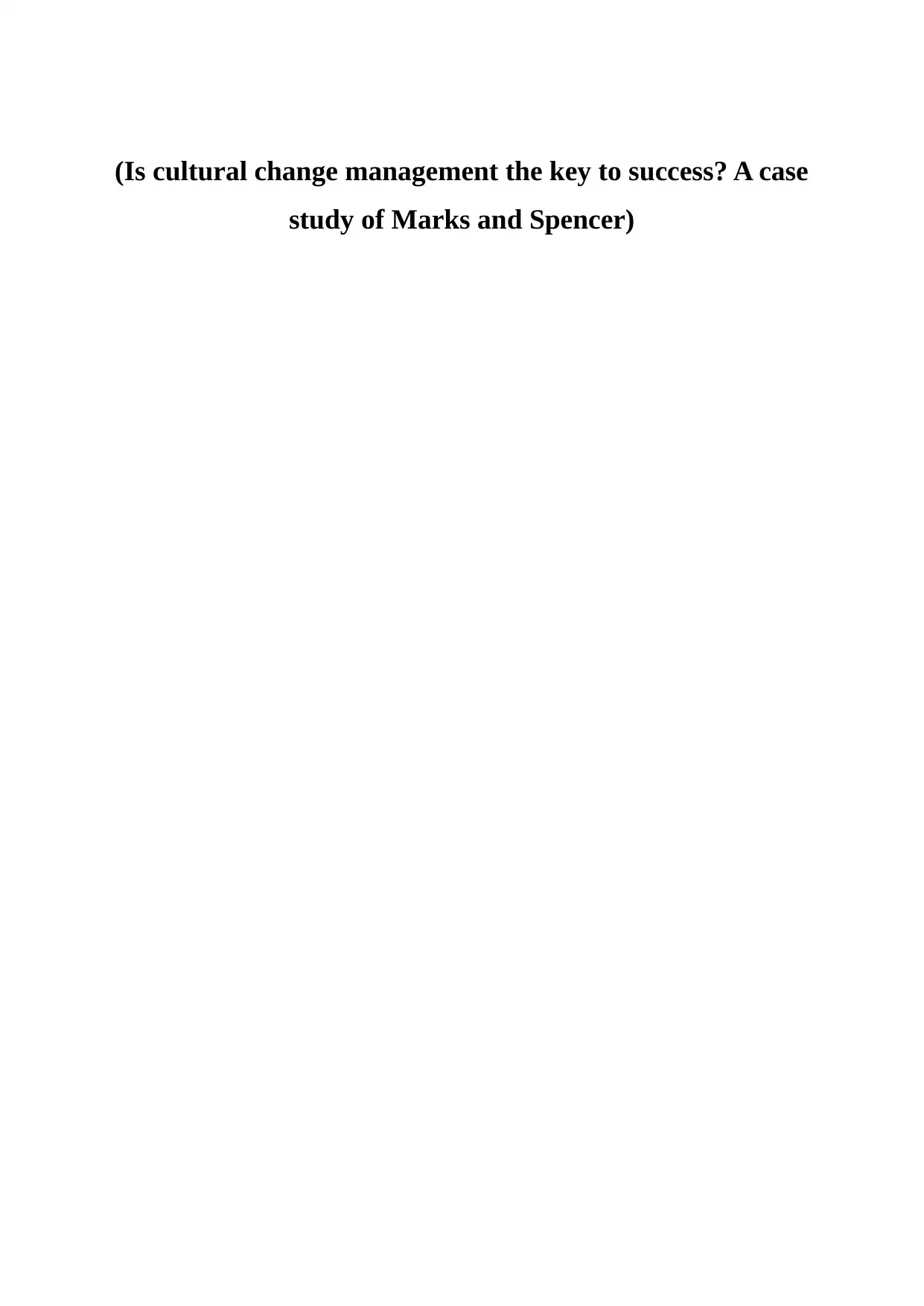
(Is cultural change management the key to success? A case
study of Marks and Spencer)
study of Marks and Spencer)
Paraphrase This Document
Need a fresh take? Get an instant paraphrase of this document with our AI Paraphraser
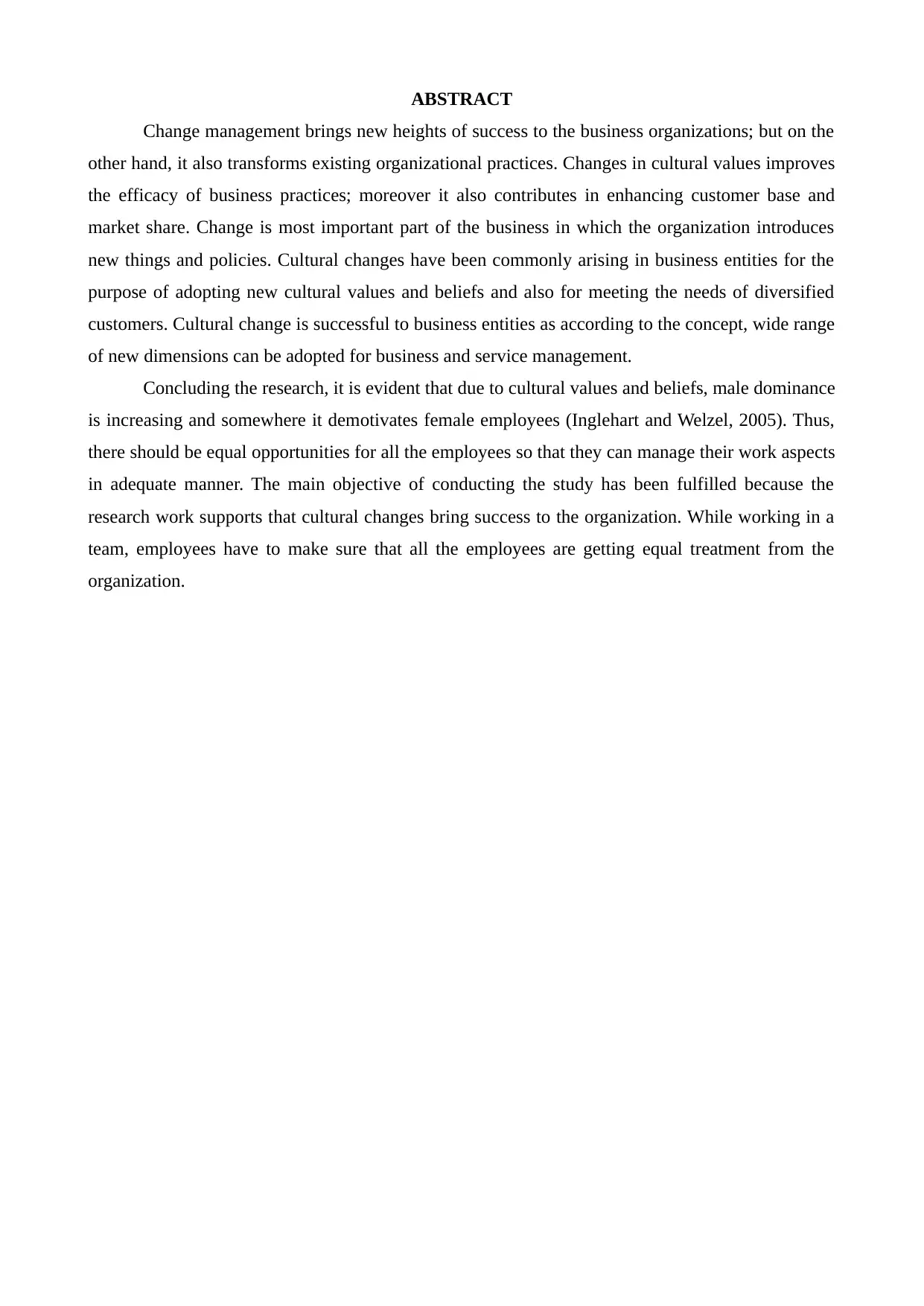
ABSTRACT
Change management brings new heights of success to the business organizations; but on the
other hand, it also transforms existing organizational practices. Changes in cultural values improves
the efficacy of business practices; moreover it also contributes in enhancing customer base and
market share. Change is most important part of the business in which the organization introduces
new things and policies. Cultural changes have been commonly arising in business entities for the
purpose of adopting new cultural values and beliefs and also for meeting the needs of diversified
customers. Cultural change is successful to business entities as according to the concept, wide range
of new dimensions can be adopted for business and service management.
Concluding the research, it is evident that due to cultural values and beliefs, male dominance
is increasing and somewhere it demotivates female employees (Inglehart and Welzel, 2005). Thus,
there should be equal opportunities for all the employees so that they can manage their work aspects
in adequate manner. The main objective of conducting the study has been fulfilled because the
research work supports that cultural changes bring success to the organization. While working in a
team, employees have to make sure that all the employees are getting equal treatment from the
organization.
Change management brings new heights of success to the business organizations; but on the
other hand, it also transforms existing organizational practices. Changes in cultural values improves
the efficacy of business practices; moreover it also contributes in enhancing customer base and
market share. Change is most important part of the business in which the organization introduces
new things and policies. Cultural changes have been commonly arising in business entities for the
purpose of adopting new cultural values and beliefs and also for meeting the needs of diversified
customers. Cultural change is successful to business entities as according to the concept, wide range
of new dimensions can be adopted for business and service management.
Concluding the research, it is evident that due to cultural values and beliefs, male dominance
is increasing and somewhere it demotivates female employees (Inglehart and Welzel, 2005). Thus,
there should be equal opportunities for all the employees so that they can manage their work aspects
in adequate manner. The main objective of conducting the study has been fulfilled because the
research work supports that cultural changes bring success to the organization. While working in a
team, employees have to make sure that all the employees are getting equal treatment from the
organization.
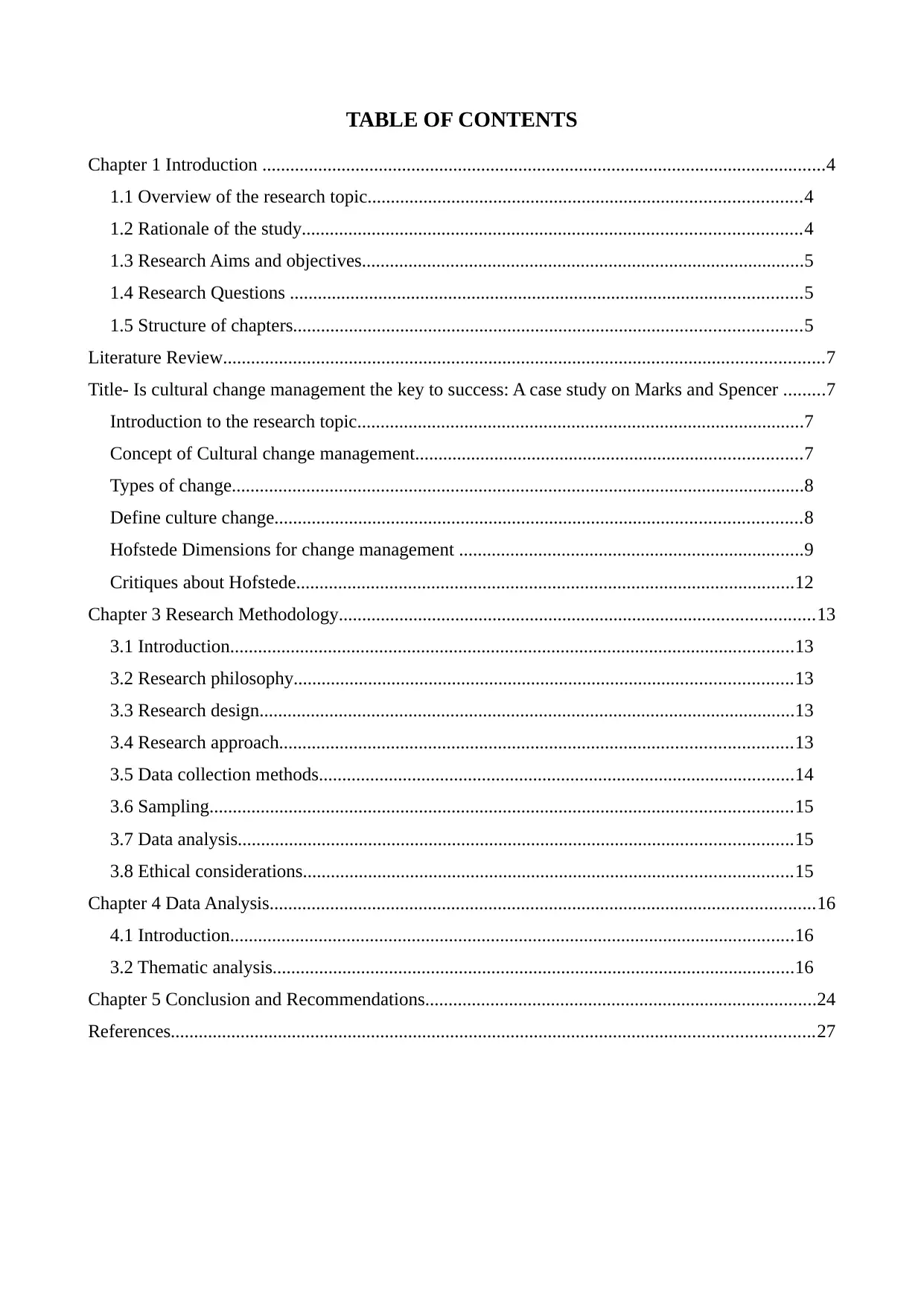
TABLE OF CONTENTS
Chapter 1 Introduction .........................................................................................................................4
1.1 Overview of the research topic.............................................................................................4
1.2 Rationale of the study...........................................................................................................4
1.3 Research Aims and objectives...............................................................................................5
1.4 Research Questions ..............................................................................................................5
1.5 Structure of chapters.............................................................................................................5
Literature Review.................................................................................................................................7
Title- Is cultural change management the key to success: A case study on Marks and Spencer .........7
Introduction to the research topic................................................................................................7
Concept of Cultural change management...................................................................................7
Types of change...........................................................................................................................8
Define culture change.................................................................................................................8
Hofstede Dimensions for change management ..........................................................................9
Critiques about Hofstede...........................................................................................................12
Chapter 3 Research Methodology......................................................................................................13
3.1 Introduction.........................................................................................................................13
3.2 Research philosophy...........................................................................................................13
3.3 Research design...................................................................................................................13
3.4 Research approach..............................................................................................................13
3.5 Data collection methods......................................................................................................14
3.6 Sampling.............................................................................................................................15
3.7 Data analysis.......................................................................................................................15
3.8 Ethical considerations.........................................................................................................15
Chapter 4 Data Analysis.....................................................................................................................16
4.1 Introduction.........................................................................................................................16
3.2 Thematic analysis................................................................................................................16
Chapter 5 Conclusion and Recommendations....................................................................................24
References..........................................................................................................................................27
Chapter 1 Introduction .........................................................................................................................4
1.1 Overview of the research topic.............................................................................................4
1.2 Rationale of the study...........................................................................................................4
1.3 Research Aims and objectives...............................................................................................5
1.4 Research Questions ..............................................................................................................5
1.5 Structure of chapters.............................................................................................................5
Literature Review.................................................................................................................................7
Title- Is cultural change management the key to success: A case study on Marks and Spencer .........7
Introduction to the research topic................................................................................................7
Concept of Cultural change management...................................................................................7
Types of change...........................................................................................................................8
Define culture change.................................................................................................................8
Hofstede Dimensions for change management ..........................................................................9
Critiques about Hofstede...........................................................................................................12
Chapter 3 Research Methodology......................................................................................................13
3.1 Introduction.........................................................................................................................13
3.2 Research philosophy...........................................................................................................13
3.3 Research design...................................................................................................................13
3.4 Research approach..............................................................................................................13
3.5 Data collection methods......................................................................................................14
3.6 Sampling.............................................................................................................................15
3.7 Data analysis.......................................................................................................................15
3.8 Ethical considerations.........................................................................................................15
Chapter 4 Data Analysis.....................................................................................................................16
4.1 Introduction.........................................................................................................................16
3.2 Thematic analysis................................................................................................................16
Chapter 5 Conclusion and Recommendations....................................................................................24
References..........................................................................................................................................27
⊘ This is a preview!⊘
Do you want full access?
Subscribe today to unlock all pages.

Trusted by 1+ million students worldwide
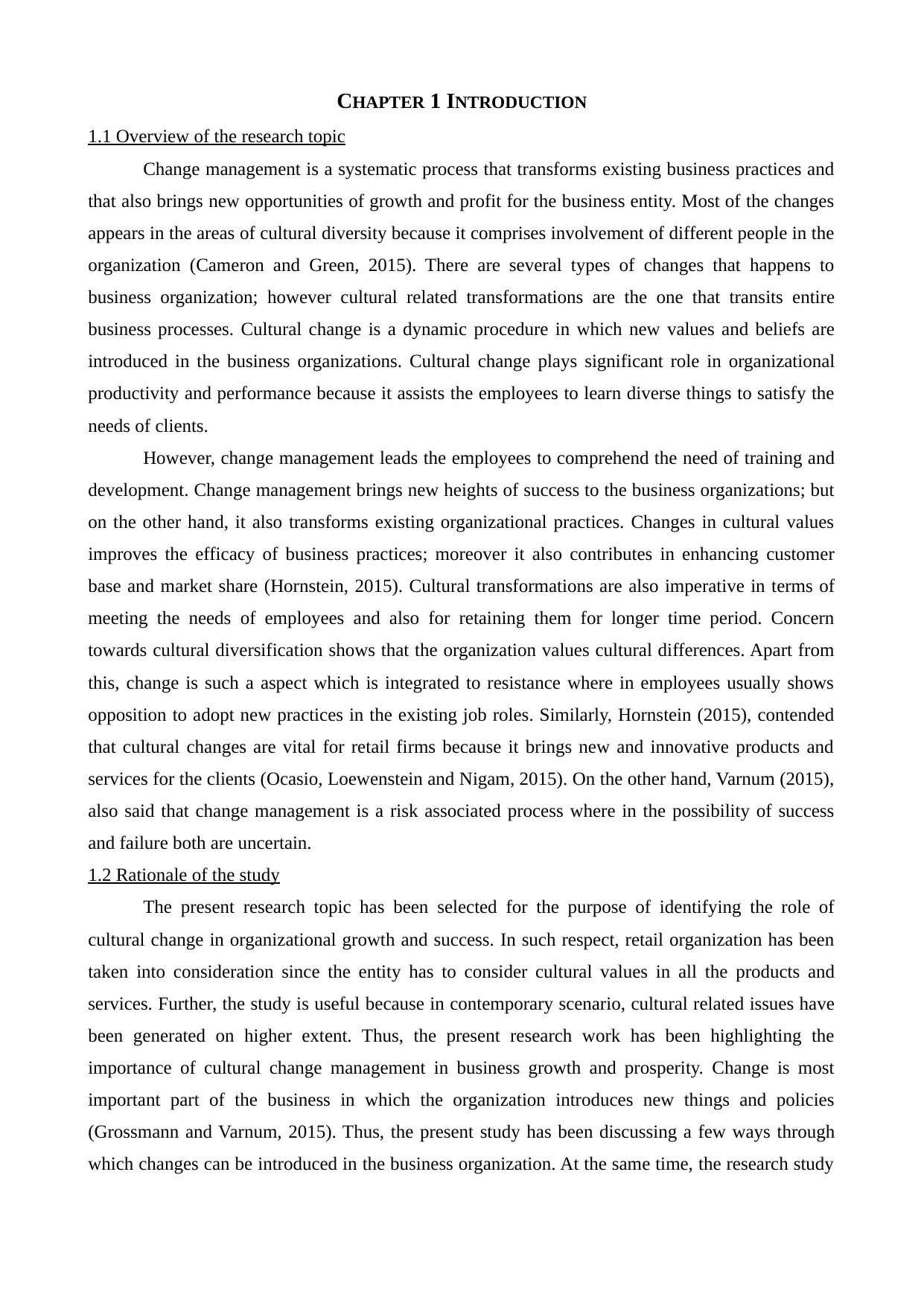
CHAPTER 1 INTRODUCTION
1.1 Overview of the research topic
Change management is a systematic process that transforms existing business practices and
that also brings new opportunities of growth and profit for the business entity. Most of the changes
appears in the areas of cultural diversity because it comprises involvement of different people in the
organization (Cameron and Green, 2015). There are several types of changes that happens to
business organization; however cultural related transformations are the one that transits entire
business processes. Cultural change is a dynamic procedure in which new values and beliefs are
introduced in the business organizations. Cultural change plays significant role in organizational
productivity and performance because it assists the employees to learn diverse things to satisfy the
needs of clients.
However, change management leads the employees to comprehend the need of training and
development. Change management brings new heights of success to the business organizations; but
on the other hand, it also transforms existing organizational practices. Changes in cultural values
improves the efficacy of business practices; moreover it also contributes in enhancing customer
base and market share (Hornstein, 2015). Cultural transformations are also imperative in terms of
meeting the needs of employees and also for retaining them for longer time period. Concern
towards cultural diversification shows that the organization values cultural differences. Apart from
this, change is such a aspect which is integrated to resistance where in employees usually shows
opposition to adopt new practices in the existing job roles. Similarly, Hornstein (2015), contended
that cultural changes are vital for retail firms because it brings new and innovative products and
services for the clients (Ocasio, Loewenstein and Nigam, 2015). On the other hand, Varnum (2015),
also said that change management is a risk associated process where in the possibility of success
and failure both are uncertain.
1.2 Rationale of the study
The present research topic has been selected for the purpose of identifying the role of
cultural change in organizational growth and success. In such respect, retail organization has been
taken into consideration since the entity has to consider cultural values in all the products and
services. Further, the study is useful because in contemporary scenario, cultural related issues have
been generated on higher extent. Thus, the present research work has been highlighting the
importance of cultural change management in business growth and prosperity. Change is most
important part of the business in which the organization introduces new things and policies
(Grossmann and Varnum, 2015). Thus, the present study has been discussing a few ways through
which changes can be introduced in the business organization. At the same time, the research study
1.1 Overview of the research topic
Change management is a systematic process that transforms existing business practices and
that also brings new opportunities of growth and profit for the business entity. Most of the changes
appears in the areas of cultural diversity because it comprises involvement of different people in the
organization (Cameron and Green, 2015). There are several types of changes that happens to
business organization; however cultural related transformations are the one that transits entire
business processes. Cultural change is a dynamic procedure in which new values and beliefs are
introduced in the business organizations. Cultural change plays significant role in organizational
productivity and performance because it assists the employees to learn diverse things to satisfy the
needs of clients.
However, change management leads the employees to comprehend the need of training and
development. Change management brings new heights of success to the business organizations; but
on the other hand, it also transforms existing organizational practices. Changes in cultural values
improves the efficacy of business practices; moreover it also contributes in enhancing customer
base and market share (Hornstein, 2015). Cultural transformations are also imperative in terms of
meeting the needs of employees and also for retaining them for longer time period. Concern
towards cultural diversification shows that the organization values cultural differences. Apart from
this, change is such a aspect which is integrated to resistance where in employees usually shows
opposition to adopt new practices in the existing job roles. Similarly, Hornstein (2015), contended
that cultural changes are vital for retail firms because it brings new and innovative products and
services for the clients (Ocasio, Loewenstein and Nigam, 2015). On the other hand, Varnum (2015),
also said that change management is a risk associated process where in the possibility of success
and failure both are uncertain.
1.2 Rationale of the study
The present research topic has been selected for the purpose of identifying the role of
cultural change in organizational growth and success. In such respect, retail organization has been
taken into consideration since the entity has to consider cultural values in all the products and
services. Further, the study is useful because in contemporary scenario, cultural related issues have
been generated on higher extent. Thus, the present research work has been highlighting the
importance of cultural change management in business growth and prosperity. Change is most
important part of the business in which the organization introduces new things and policies
(Grossmann and Varnum, 2015). Thus, the present study has been discussing a few ways through
which changes can be introduced in the business organization. At the same time, the research study
Paraphrase This Document
Need a fresh take? Get an instant paraphrase of this document with our AI Paraphraser
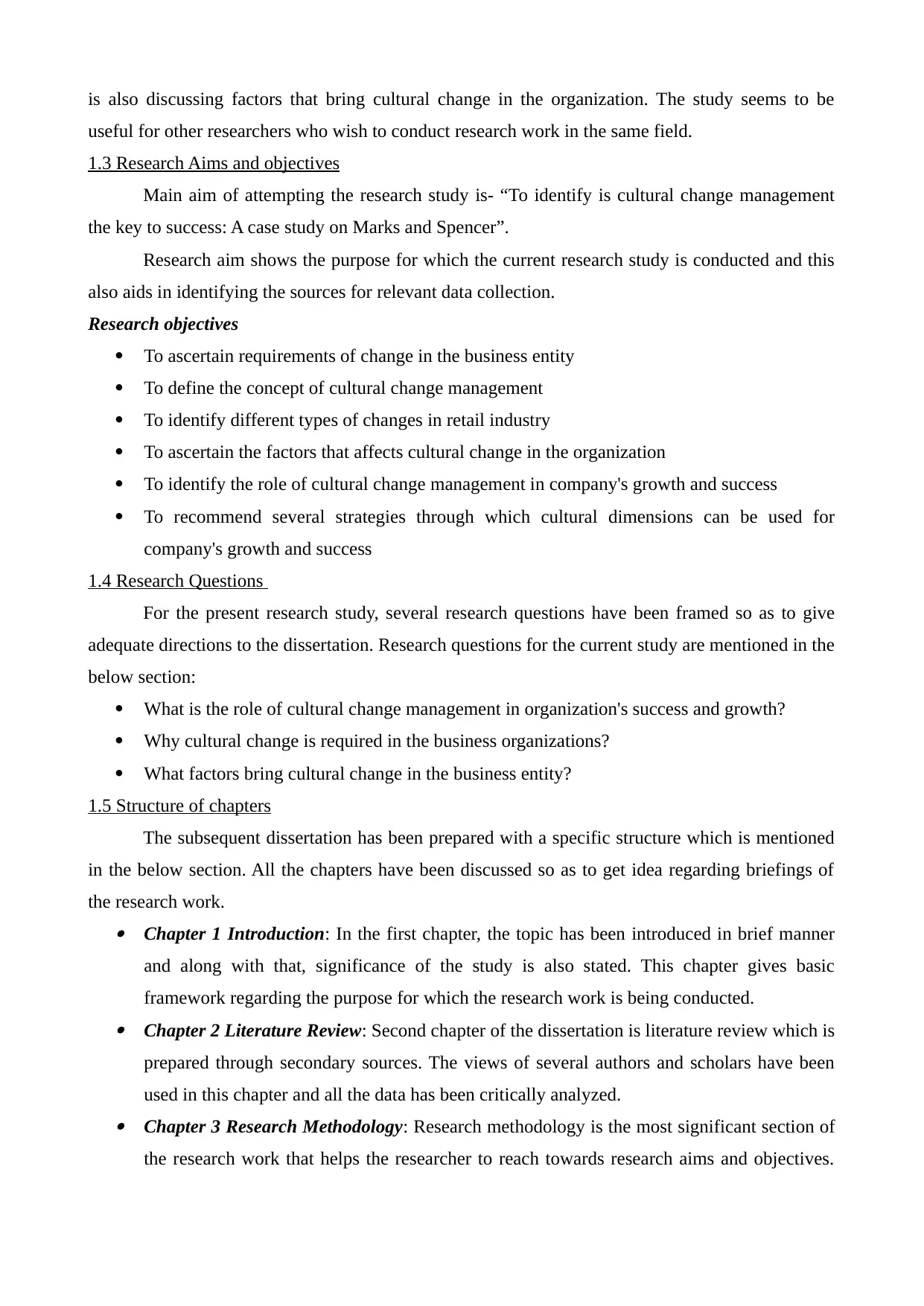
is also discussing factors that bring cultural change in the organization. The study seems to be
useful for other researchers who wish to conduct research work in the same field.
1.3 Research Aims and objectives
Main aim of attempting the research study is- “To identify is cultural change management
the key to success: A case study on Marks and Spencer”.
Research aim shows the purpose for which the current research study is conducted and this
also aids in identifying the sources for relevant data collection.
Research objectives
To ascertain requirements of change in the business entity
To define the concept of cultural change management
To identify different types of changes in retail industry
To ascertain the factors that affects cultural change in the organization
To identify the role of cultural change management in company's growth and success
To recommend several strategies through which cultural dimensions can be used for
company's growth and success
1.4 Research Questions
For the present research study, several research questions have been framed so as to give
adequate directions to the dissertation. Research questions for the current study are mentioned in the
below section:
What is the role of cultural change management in organization's success and growth?
Why cultural change is required in the business organizations?
What factors bring cultural change in the business entity?
1.5 Structure of chapters
The subsequent dissertation has been prepared with a specific structure which is mentioned
in the below section. All the chapters have been discussed so as to get idea regarding briefings of
the research work. Chapter 1 Introduction: In the first chapter, the topic has been introduced in brief manner
and along with that, significance of the study is also stated. This chapter gives basic
framework regarding the purpose for which the research work is being conducted. Chapter 2 Literature Review: Second chapter of the dissertation is literature review which is
prepared through secondary sources. The views of several authors and scholars have been
used in this chapter and all the data has been critically analyzed. Chapter 3 Research Methodology: Research methodology is the most significant section of
the research work that helps the researcher to reach towards research aims and objectives.
useful for other researchers who wish to conduct research work in the same field.
1.3 Research Aims and objectives
Main aim of attempting the research study is- “To identify is cultural change management
the key to success: A case study on Marks and Spencer”.
Research aim shows the purpose for which the current research study is conducted and this
also aids in identifying the sources for relevant data collection.
Research objectives
To ascertain requirements of change in the business entity
To define the concept of cultural change management
To identify different types of changes in retail industry
To ascertain the factors that affects cultural change in the organization
To identify the role of cultural change management in company's growth and success
To recommend several strategies through which cultural dimensions can be used for
company's growth and success
1.4 Research Questions
For the present research study, several research questions have been framed so as to give
adequate directions to the dissertation. Research questions for the current study are mentioned in the
below section:
What is the role of cultural change management in organization's success and growth?
Why cultural change is required in the business organizations?
What factors bring cultural change in the business entity?
1.5 Structure of chapters
The subsequent dissertation has been prepared with a specific structure which is mentioned
in the below section. All the chapters have been discussed so as to get idea regarding briefings of
the research work. Chapter 1 Introduction: In the first chapter, the topic has been introduced in brief manner
and along with that, significance of the study is also stated. This chapter gives basic
framework regarding the purpose for which the research work is being conducted. Chapter 2 Literature Review: Second chapter of the dissertation is literature review which is
prepared through secondary sources. The views of several authors and scholars have been
used in this chapter and all the data has been critically analyzed. Chapter 3 Research Methodology: Research methodology is the most significant section of
the research work that helps the researcher to reach towards research aims and objectives.
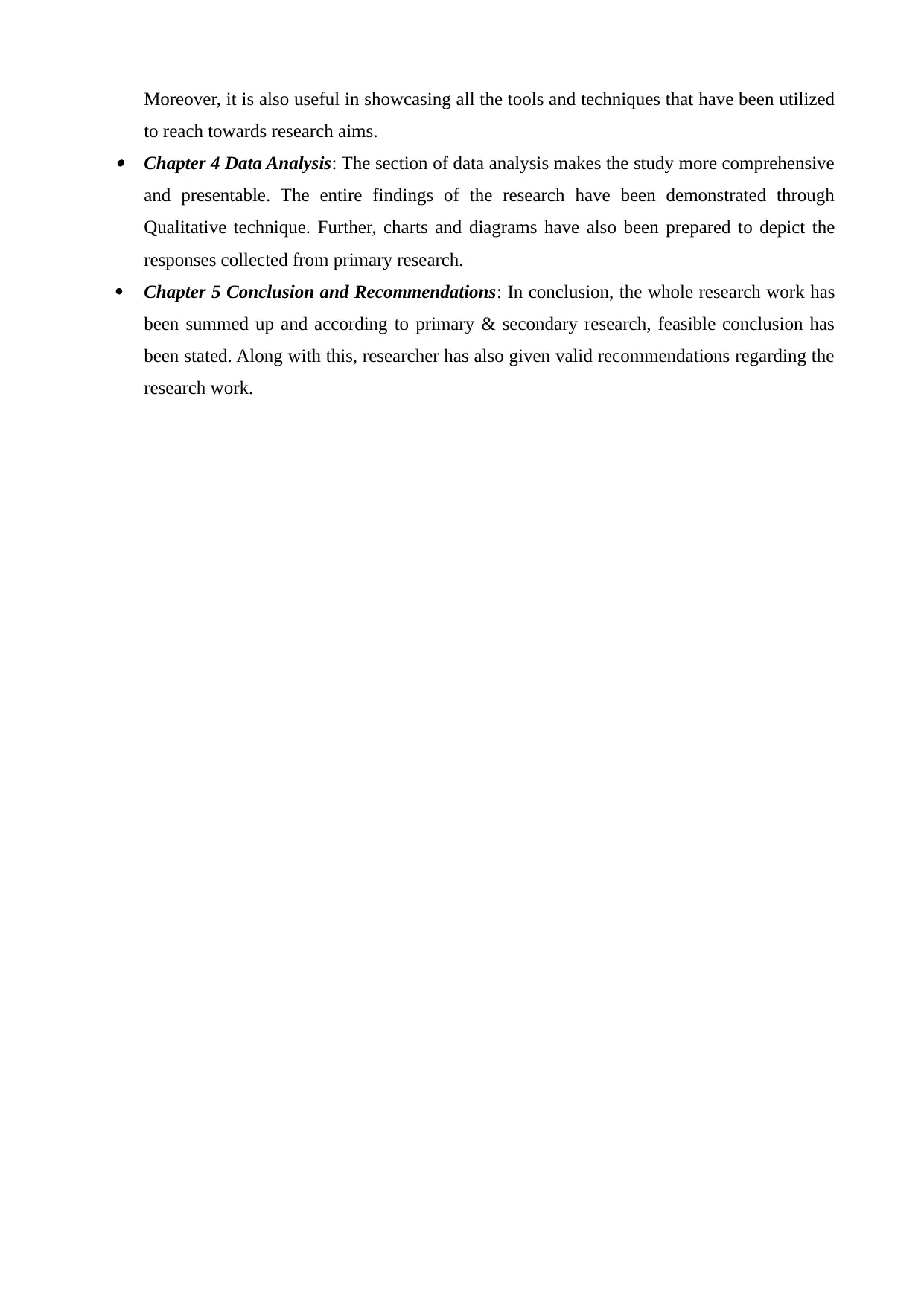
Moreover, it is also useful in showcasing all the tools and techniques that have been utilized
to reach towards research aims. Chapter 4 Data Analysis: The section of data analysis makes the study more comprehensive
and presentable. The entire findings of the research have been demonstrated through
Qualitative technique. Further, charts and diagrams have also been prepared to depict the
responses collected from primary research.
Chapter 5 Conclusion and Recommendations: In conclusion, the whole research work has
been summed up and according to primary & secondary research, feasible conclusion has
been stated. Along with this, researcher has also given valid recommendations regarding the
research work.
to reach towards research aims. Chapter 4 Data Analysis: The section of data analysis makes the study more comprehensive
and presentable. The entire findings of the research have been demonstrated through
Qualitative technique. Further, charts and diagrams have also been prepared to depict the
responses collected from primary research.
Chapter 5 Conclusion and Recommendations: In conclusion, the whole research work has
been summed up and according to primary & secondary research, feasible conclusion has
been stated. Along with this, researcher has also given valid recommendations regarding the
research work.
⊘ This is a preview!⊘
Do you want full access?
Subscribe today to unlock all pages.

Trusted by 1+ million students worldwide
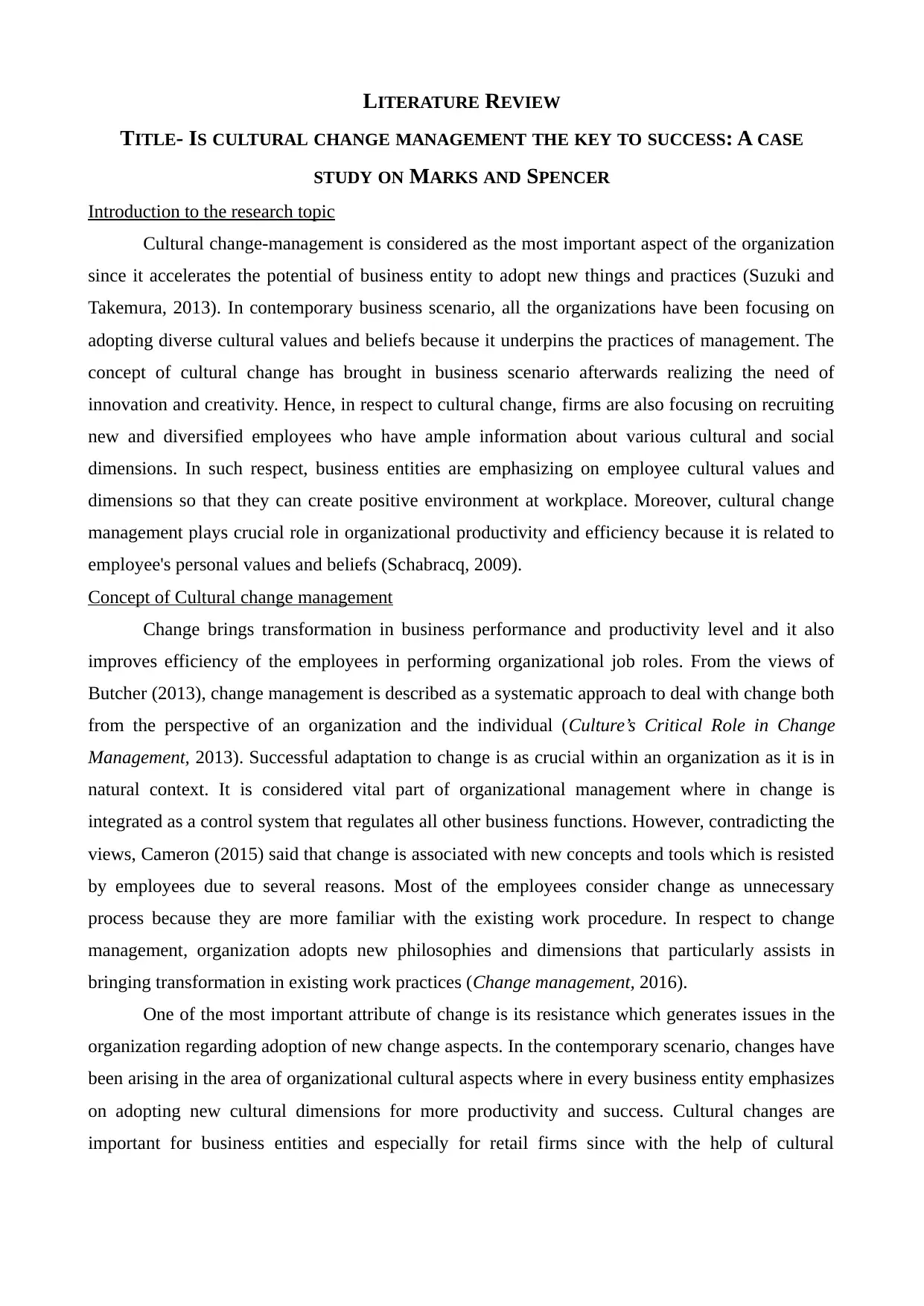
LITERATURE REVIEW
TITLE- IS CULTURAL CHANGE MANAGEMENT THE KEY TO SUCCESS: A CASE
STUDY ON MARKS AND SPENCER
Introduction to the research topic
Cultural change-management is considered as the most important aspect of the organization
since it accelerates the potential of business entity to adopt new things and practices (Suzuki and
Takemura, 2013). In contemporary business scenario, all the organizations have been focusing on
adopting diverse cultural values and beliefs because it underpins the practices of management. The
concept of cultural change has brought in business scenario afterwards realizing the need of
innovation and creativity. Hence, in respect to cultural change, firms are also focusing on recruiting
new and diversified employees who have ample information about various cultural and social
dimensions. In such respect, business entities are emphasizing on employee cultural values and
dimensions so that they can create positive environment at workplace. Moreover, cultural change
management plays crucial role in organizational productivity and efficiency because it is related to
employee's personal values and beliefs (Schabracq, 2009).
Concept of Cultural change management
Change brings transformation in business performance and productivity level and it also
improves efficiency of the employees in performing organizational job roles. From the views of
Butcher (2013), change management is described as a systematic approach to deal with change both
from the perspective of an organization and the individual (Culture’s Critical Role in Change
Management, 2013). Successful adaptation to change is as crucial within an organization as it is in
natural context. It is considered vital part of organizational management where in change is
integrated as a control system that regulates all other business functions. However, contradicting the
views, Cameron (2015) said that change is associated with new concepts and tools which is resisted
by employees due to several reasons. Most of the employees consider change as unnecessary
process because they are more familiar with the existing work procedure. In respect to change
management, organization adopts new philosophies and dimensions that particularly assists in
bringing transformation in existing work practices (Change management, 2016).
One of the most important attribute of change is its resistance which generates issues in the
organization regarding adoption of new change aspects. In the contemporary scenario, changes have
been arising in the area of organizational cultural aspects where in every business entity emphasizes
on adopting new cultural dimensions for more productivity and success. Cultural changes are
important for business entities and especially for retail firms since with the help of cultural
TITLE- IS CULTURAL CHANGE MANAGEMENT THE KEY TO SUCCESS: A CASE
STUDY ON MARKS AND SPENCER
Introduction to the research topic
Cultural change-management is considered as the most important aspect of the organization
since it accelerates the potential of business entity to adopt new things and practices (Suzuki and
Takemura, 2013). In contemporary business scenario, all the organizations have been focusing on
adopting diverse cultural values and beliefs because it underpins the practices of management. The
concept of cultural change has brought in business scenario afterwards realizing the need of
innovation and creativity. Hence, in respect to cultural change, firms are also focusing on recruiting
new and diversified employees who have ample information about various cultural and social
dimensions. In such respect, business entities are emphasizing on employee cultural values and
dimensions so that they can create positive environment at workplace. Moreover, cultural change
management plays crucial role in organizational productivity and efficiency because it is related to
employee's personal values and beliefs (Schabracq, 2009).
Concept of Cultural change management
Change brings transformation in business performance and productivity level and it also
improves efficiency of the employees in performing organizational job roles. From the views of
Butcher (2013), change management is described as a systematic approach to deal with change both
from the perspective of an organization and the individual (Culture’s Critical Role in Change
Management, 2013). Successful adaptation to change is as crucial within an organization as it is in
natural context. It is considered vital part of organizational management where in change is
integrated as a control system that regulates all other business functions. However, contradicting the
views, Cameron (2015) said that change is associated with new concepts and tools which is resisted
by employees due to several reasons. Most of the employees consider change as unnecessary
process because they are more familiar with the existing work procedure. In respect to change
management, organization adopts new philosophies and dimensions that particularly assists in
bringing transformation in existing work practices (Change management, 2016).
One of the most important attribute of change is its resistance which generates issues in the
organization regarding adoption of new change aspects. In the contemporary scenario, changes have
been arising in the area of organizational cultural aspects where in every business entity emphasizes
on adopting new cultural dimensions for more productivity and success. Cultural changes are
important for business entities and especially for retail firms since with the help of cultural
Paraphrase This Document
Need a fresh take? Get an instant paraphrase of this document with our AI Paraphraser
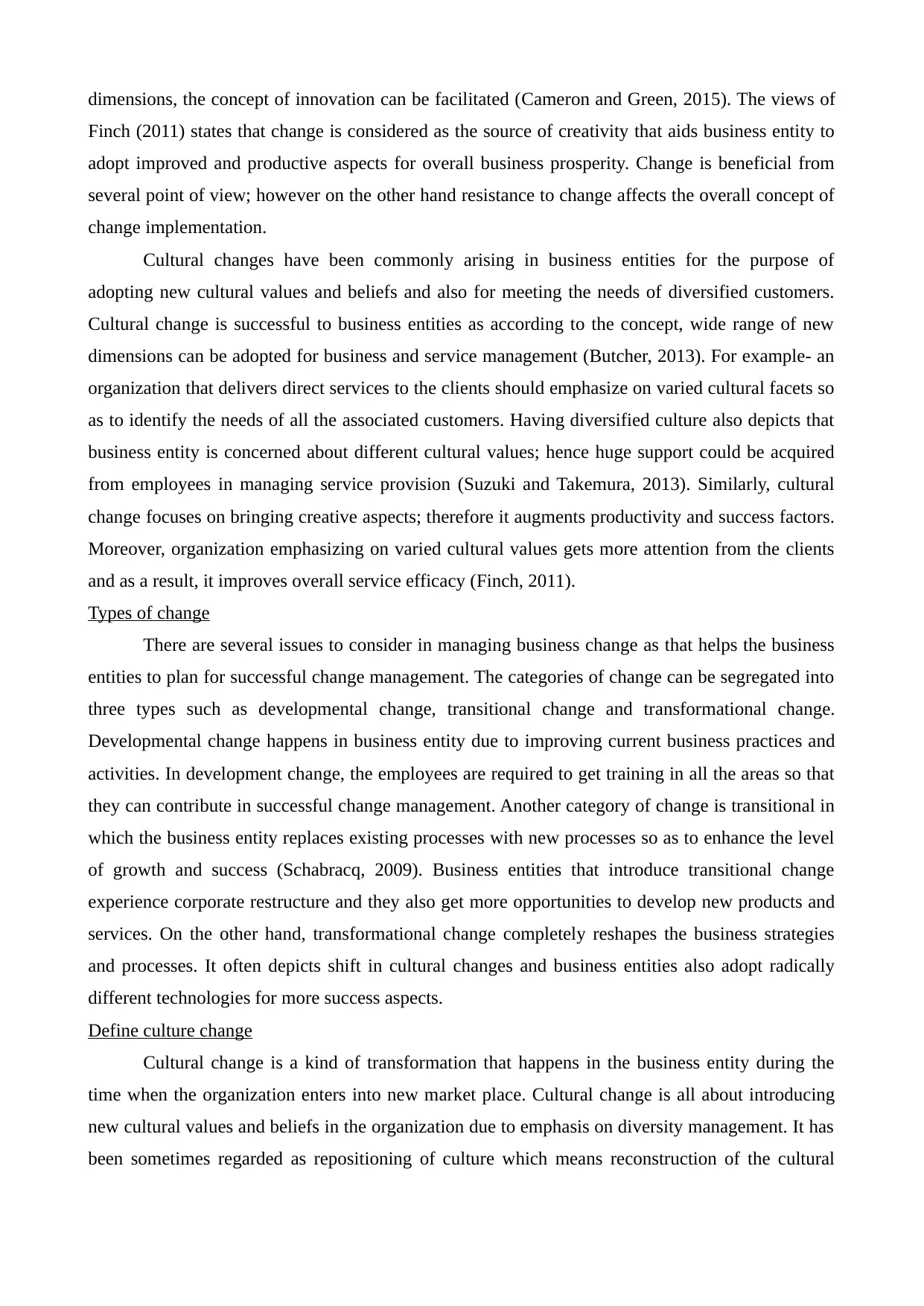
dimensions, the concept of innovation can be facilitated (Cameron and Green, 2015). The views of
Finch (2011) states that change is considered as the source of creativity that aids business entity to
adopt improved and productive aspects for overall business prosperity. Change is beneficial from
several point of view; however on the other hand resistance to change affects the overall concept of
change implementation.
Cultural changes have been commonly arising in business entities for the purpose of
adopting new cultural values and beliefs and also for meeting the needs of diversified customers.
Cultural change is successful to business entities as according to the concept, wide range of new
dimensions can be adopted for business and service management (Butcher, 2013). For example- an
organization that delivers direct services to the clients should emphasize on varied cultural facets so
as to identify the needs of all the associated customers. Having diversified culture also depicts that
business entity is concerned about different cultural values; hence huge support could be acquired
from employees in managing service provision (Suzuki and Takemura, 2013). Similarly, cultural
change focuses on bringing creative aspects; therefore it augments productivity and success factors.
Moreover, organization emphasizing on varied cultural values gets more attention from the clients
and as a result, it improves overall service efficacy (Finch, 2011).
Types of change
There are several issues to consider in managing business change as that helps the business
entities to plan for successful change management. The categories of change can be segregated into
three types such as developmental change, transitional change and transformational change.
Developmental change happens in business entity due to improving current business practices and
activities. In development change, the employees are required to get training in all the areas so that
they can contribute in successful change management. Another category of change is transitional in
which the business entity replaces existing processes with new processes so as to enhance the level
of growth and success (Schabracq, 2009). Business entities that introduce transitional change
experience corporate restructure and they also get more opportunities to develop new products and
services. On the other hand, transformational change completely reshapes the business strategies
and processes. It often depicts shift in cultural changes and business entities also adopt radically
different technologies for more success aspects.
Define culture change
Cultural change is a kind of transformation that happens in the business entity during the
time when the organization enters into new market place. Cultural change is all about introducing
new cultural values and beliefs in the organization due to emphasis on diversity management. It has
been sometimes regarded as repositioning of culture which means reconstruction of the cultural
Finch (2011) states that change is considered as the source of creativity that aids business entity to
adopt improved and productive aspects for overall business prosperity. Change is beneficial from
several point of view; however on the other hand resistance to change affects the overall concept of
change implementation.
Cultural changes have been commonly arising in business entities for the purpose of
adopting new cultural values and beliefs and also for meeting the needs of diversified customers.
Cultural change is successful to business entities as according to the concept, wide range of new
dimensions can be adopted for business and service management (Butcher, 2013). For example- an
organization that delivers direct services to the clients should emphasize on varied cultural facets so
as to identify the needs of all the associated customers. Having diversified culture also depicts that
business entity is concerned about different cultural values; hence huge support could be acquired
from employees in managing service provision (Suzuki and Takemura, 2013). Similarly, cultural
change focuses on bringing creative aspects; therefore it augments productivity and success factors.
Moreover, organization emphasizing on varied cultural values gets more attention from the clients
and as a result, it improves overall service efficacy (Finch, 2011).
Types of change
There are several issues to consider in managing business change as that helps the business
entities to plan for successful change management. The categories of change can be segregated into
three types such as developmental change, transitional change and transformational change.
Developmental change happens in business entity due to improving current business practices and
activities. In development change, the employees are required to get training in all the areas so that
they can contribute in successful change management. Another category of change is transitional in
which the business entity replaces existing processes with new processes so as to enhance the level
of growth and success (Schabracq, 2009). Business entities that introduce transitional change
experience corporate restructure and they also get more opportunities to develop new products and
services. On the other hand, transformational change completely reshapes the business strategies
and processes. It often depicts shift in cultural changes and business entities also adopt radically
different technologies for more success aspects.
Define culture change
Cultural change is a kind of transformation that happens in the business entity during the
time when the organization enters into new market place. Cultural change is all about introducing
new cultural values and beliefs in the organization due to emphasis on diversity management. It has
been sometimes regarded as repositioning of culture which means reconstruction of the cultural
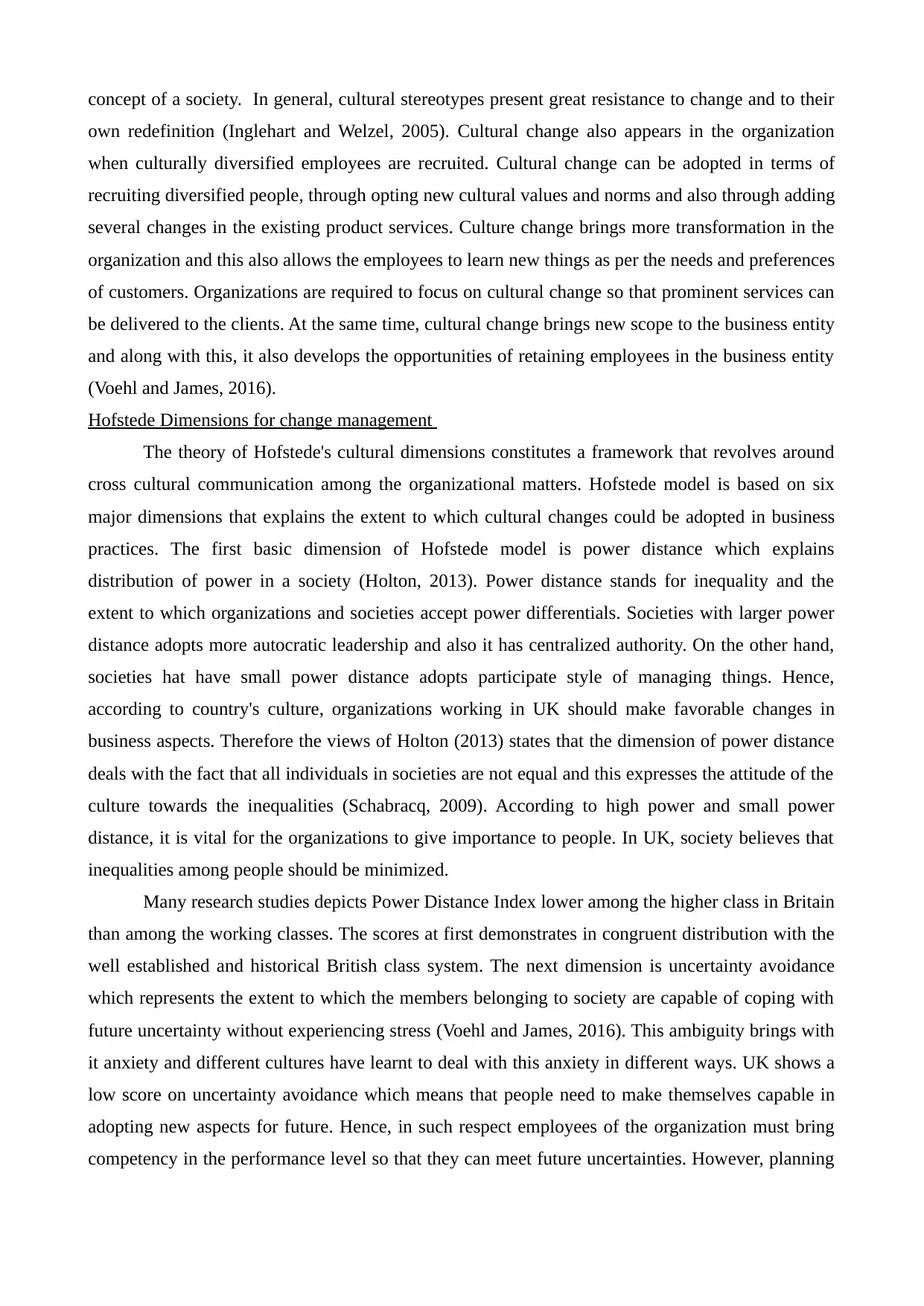
concept of a society. In general, cultural stereotypes present great resistance to change and to their
own redefinition (Inglehart and Welzel, 2005). Cultural change also appears in the organization
when culturally diversified employees are recruited. Cultural change can be adopted in terms of
recruiting diversified people, through opting new cultural values and norms and also through adding
several changes in the existing product services. Culture change brings more transformation in the
organization and this also allows the employees to learn new things as per the needs and preferences
of customers. Organizations are required to focus on cultural change so that prominent services can
be delivered to the clients. At the same time, cultural change brings new scope to the business entity
and along with this, it also develops the opportunities of retaining employees in the business entity
(Voehl and James, 2016).
Hofstede Dimensions for change management
The theory of Hofstede's cultural dimensions constitutes a framework that revolves around
cross cultural communication among the organizational matters. Hofstede model is based on six
major dimensions that explains the extent to which cultural changes could be adopted in business
practices. The first basic dimension of Hofstede model is power distance which explains
distribution of power in a society (Holton, 2013). Power distance stands for inequality and the
extent to which organizations and societies accept power differentials. Societies with larger power
distance adopts more autocratic leadership and also it has centralized authority. On the other hand,
societies hat have small power distance adopts participate style of managing things. Hence,
according to country's culture, organizations working in UK should make favorable changes in
business aspects. Therefore the views of Holton (2013) states that the dimension of power distance
deals with the fact that all individuals in societies are not equal and this expresses the attitude of the
culture towards the inequalities (Schabracq, 2009). According to high power and small power
distance, it is vital for the organizations to give importance to people. In UK, society believes that
inequalities among people should be minimized.
Many research studies depicts Power Distance Index lower among the higher class in Britain
than among the working classes. The scores at first demonstrates in congruent distribution with the
well established and historical British class system. The next dimension is uncertainty avoidance
which represents the extent to which the members belonging to society are capable of coping with
future uncertainty without experiencing stress (Voehl and James, 2016). This ambiguity brings with
it anxiety and different cultures have learnt to deal with this anxiety in different ways. UK shows a
low score on uncertainty avoidance which means that people need to make themselves capable in
adopting new aspects for future. Hence, in such respect employees of the organization must bring
competency in the performance level so that they can meet future uncertainties. However, planning
own redefinition (Inglehart and Welzel, 2005). Cultural change also appears in the organization
when culturally diversified employees are recruited. Cultural change can be adopted in terms of
recruiting diversified people, through opting new cultural values and norms and also through adding
several changes in the existing product services. Culture change brings more transformation in the
organization and this also allows the employees to learn new things as per the needs and preferences
of customers. Organizations are required to focus on cultural change so that prominent services can
be delivered to the clients. At the same time, cultural change brings new scope to the business entity
and along with this, it also develops the opportunities of retaining employees in the business entity
(Voehl and James, 2016).
Hofstede Dimensions for change management
The theory of Hofstede's cultural dimensions constitutes a framework that revolves around
cross cultural communication among the organizational matters. Hofstede model is based on six
major dimensions that explains the extent to which cultural changes could be adopted in business
practices. The first basic dimension of Hofstede model is power distance which explains
distribution of power in a society (Holton, 2013). Power distance stands for inequality and the
extent to which organizations and societies accept power differentials. Societies with larger power
distance adopts more autocratic leadership and also it has centralized authority. On the other hand,
societies hat have small power distance adopts participate style of managing things. Hence,
according to country's culture, organizations working in UK should make favorable changes in
business aspects. Therefore the views of Holton (2013) states that the dimension of power distance
deals with the fact that all individuals in societies are not equal and this expresses the attitude of the
culture towards the inequalities (Schabracq, 2009). According to high power and small power
distance, it is vital for the organizations to give importance to people. In UK, society believes that
inequalities among people should be minimized.
Many research studies depicts Power Distance Index lower among the higher class in Britain
than among the working classes. The scores at first demonstrates in congruent distribution with the
well established and historical British class system. The next dimension is uncertainty avoidance
which represents the extent to which the members belonging to society are capable of coping with
future uncertainty without experiencing stress (Voehl and James, 2016). This ambiguity brings with
it anxiety and different cultures have learnt to deal with this anxiety in different ways. UK shows a
low score on uncertainty avoidance which means that people need to make themselves capable in
adopting new aspects for future. Hence, in such respect employees of the organization must bring
competency in the performance level so that they can meet future uncertainties. However, planning
⊘ This is a preview!⊘
Do you want full access?
Subscribe today to unlock all pages.

Trusted by 1+ million students worldwide
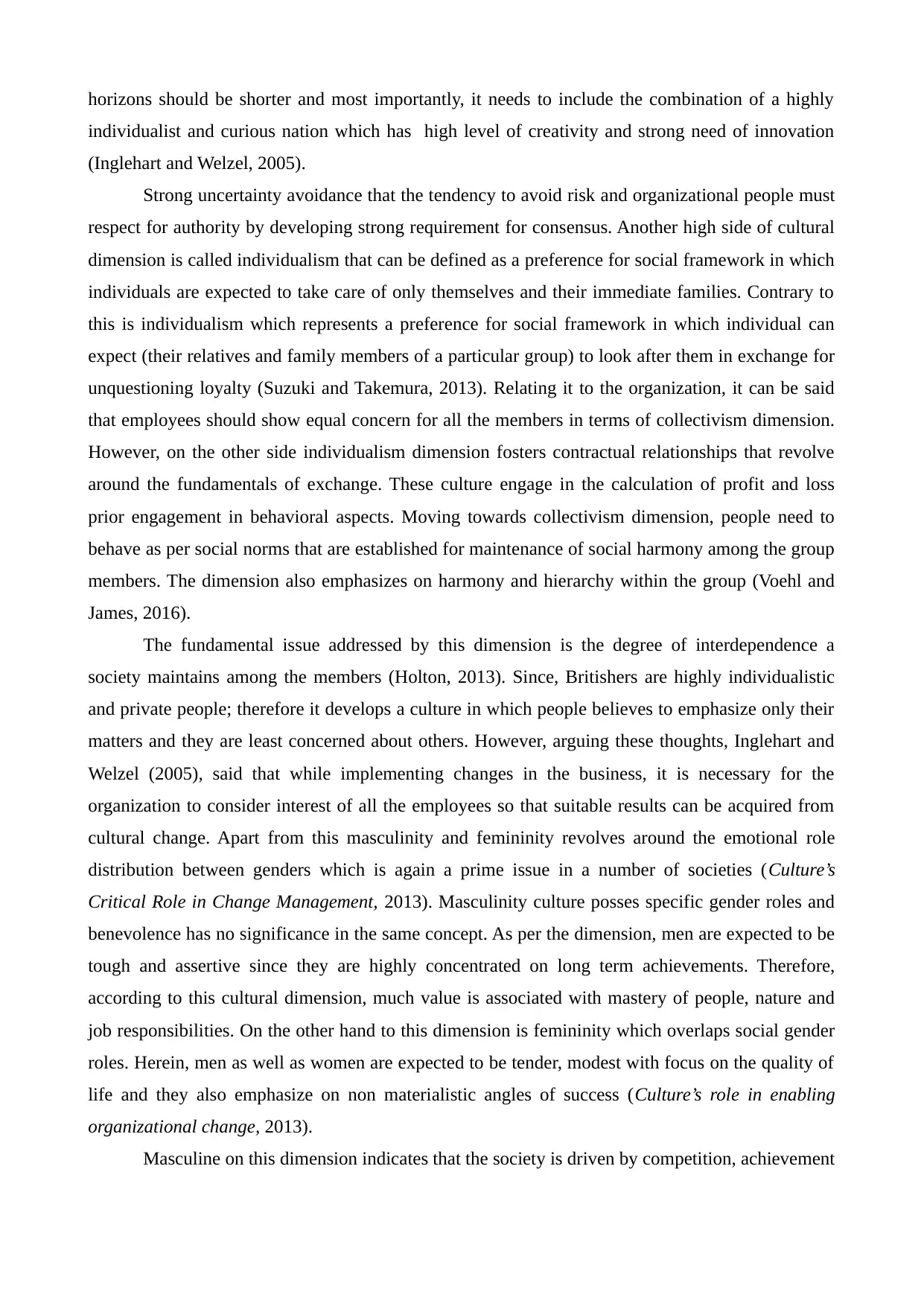
horizons should be shorter and most importantly, it needs to include the combination of a highly
individualist and curious nation which has high level of creativity and strong need of innovation
(Inglehart and Welzel, 2005).
Strong uncertainty avoidance that the tendency to avoid risk and organizational people must
respect for authority by developing strong requirement for consensus. Another high side of cultural
dimension is called individualism that can be defined as a preference for social framework in which
individuals are expected to take care of only themselves and their immediate families. Contrary to
this is individualism which represents a preference for social framework in which individual can
expect (their relatives and family members of a particular group) to look after them in exchange for
unquestioning loyalty (Suzuki and Takemura, 2013). Relating it to the organization, it can be said
that employees should show equal concern for all the members in terms of collectivism dimension.
However, on the other side individualism dimension fosters contractual relationships that revolve
around the fundamentals of exchange. These culture engage in the calculation of profit and loss
prior engagement in behavioral aspects. Moving towards collectivism dimension, people need to
behave as per social norms that are established for maintenance of social harmony among the group
members. The dimension also emphasizes on harmony and hierarchy within the group (Voehl and
James, 2016).
The fundamental issue addressed by this dimension is the degree of interdependence a
society maintains among the members (Holton, 2013). Since, Britishers are highly individualistic
and private people; therefore it develops a culture in which people believes to emphasize only their
matters and they are least concerned about others. However, arguing these thoughts, Inglehart and
Welzel (2005), said that while implementing changes in the business, it is necessary for the
organization to consider interest of all the employees so that suitable results can be acquired from
cultural change. Apart from this masculinity and femininity revolves around the emotional role
distribution between genders which is again a prime issue in a number of societies (Culture’s
Critical Role in Change Management, 2013). Masculinity culture posses specific gender roles and
benevolence has no significance in the same concept. As per the dimension, men are expected to be
tough and assertive since they are highly concentrated on long term achievements. Therefore,
according to this cultural dimension, much value is associated with mastery of people, nature and
job responsibilities. On the other hand to this dimension is femininity which overlaps social gender
roles. Herein, men as well as women are expected to be tender, modest with focus on the quality of
life and they also emphasize on non materialistic angles of success (Culture’s role in enabling
organizational change, 2013).
Masculine on this dimension indicates that the society is driven by competition, achievement
individualist and curious nation which has high level of creativity and strong need of innovation
(Inglehart and Welzel, 2005).
Strong uncertainty avoidance that the tendency to avoid risk and organizational people must
respect for authority by developing strong requirement for consensus. Another high side of cultural
dimension is called individualism that can be defined as a preference for social framework in which
individuals are expected to take care of only themselves and their immediate families. Contrary to
this is individualism which represents a preference for social framework in which individual can
expect (their relatives and family members of a particular group) to look after them in exchange for
unquestioning loyalty (Suzuki and Takemura, 2013). Relating it to the organization, it can be said
that employees should show equal concern for all the members in terms of collectivism dimension.
However, on the other side individualism dimension fosters contractual relationships that revolve
around the fundamentals of exchange. These culture engage in the calculation of profit and loss
prior engagement in behavioral aspects. Moving towards collectivism dimension, people need to
behave as per social norms that are established for maintenance of social harmony among the group
members. The dimension also emphasizes on harmony and hierarchy within the group (Voehl and
James, 2016).
The fundamental issue addressed by this dimension is the degree of interdependence a
society maintains among the members (Holton, 2013). Since, Britishers are highly individualistic
and private people; therefore it develops a culture in which people believes to emphasize only their
matters and they are least concerned about others. However, arguing these thoughts, Inglehart and
Welzel (2005), said that while implementing changes in the business, it is necessary for the
organization to consider interest of all the employees so that suitable results can be acquired from
cultural change. Apart from this masculinity and femininity revolves around the emotional role
distribution between genders which is again a prime issue in a number of societies (Culture’s
Critical Role in Change Management, 2013). Masculinity culture posses specific gender roles and
benevolence has no significance in the same concept. As per the dimension, men are expected to be
tough and assertive since they are highly concentrated on long term achievements. Therefore,
according to this cultural dimension, much value is associated with mastery of people, nature and
job responsibilities. On the other hand to this dimension is femininity which overlaps social gender
roles. Herein, men as well as women are expected to be tender, modest with focus on the quality of
life and they also emphasize on non materialistic angles of success (Culture’s role in enabling
organizational change, 2013).
Masculine on this dimension indicates that the society is driven by competition, achievement
Paraphrase This Document
Need a fresh take? Get an instant paraphrase of this document with our AI Paraphraser
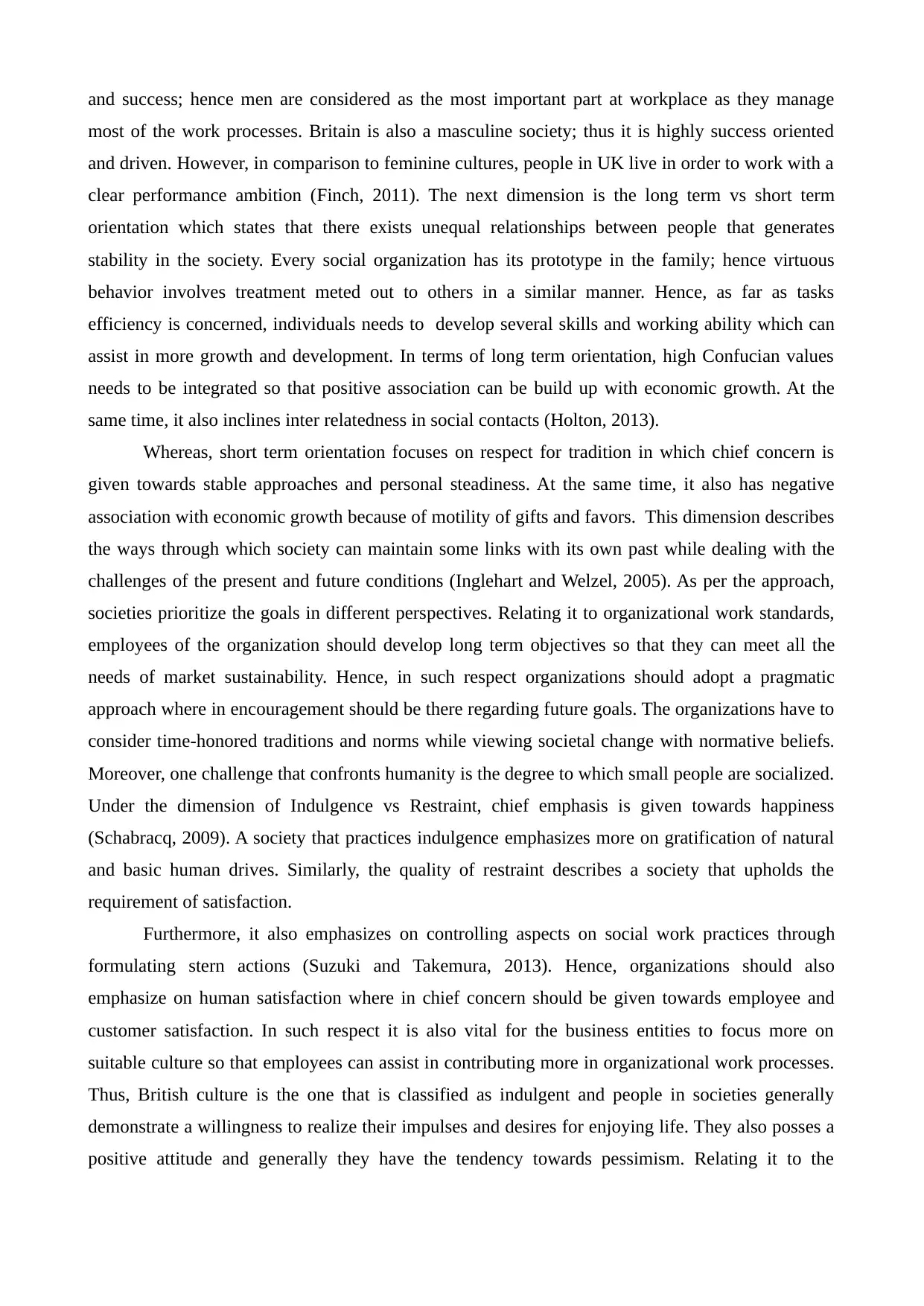
and success; hence men are considered as the most important part at workplace as they manage
most of the work processes. Britain is also a masculine society; thus it is highly success oriented
and driven. However, in comparison to feminine cultures, people in UK live in order to work with a
clear performance ambition (Finch, 2011). The next dimension is the long term vs short term
orientation which states that there exists unequal relationships between people that generates
stability in the society. Every social organization has its prototype in the family; hence virtuous
behavior involves treatment meted out to others in a similar manner. Hence, as far as tasks
efficiency is concerned, individuals needs to develop several skills and working ability which can
assist in more growth and development. In terms of long term orientation, high Confucian values
needs to be integrated so that positive association can be build up with economic growth. At the
same time, it also inclines inter relatedness in social contacts (Holton, 2013).
Whereas, short term orientation focuses on respect for tradition in which chief concern is
given towards stable approaches and personal steadiness. At the same time, it also has negative
association with economic growth because of motility of gifts and favors. This dimension describes
the ways through which society can maintain some links with its own past while dealing with the
challenges of the present and future conditions (Inglehart and Welzel, 2005). As per the approach,
societies prioritize the goals in different perspectives. Relating it to organizational work standards,
employees of the organization should develop long term objectives so that they can meet all the
needs of market sustainability. Hence, in such respect organizations should adopt a pragmatic
approach where in encouragement should be there regarding future goals. The organizations have to
consider time-honored traditions and norms while viewing societal change with normative beliefs.
Moreover, one challenge that confronts humanity is the degree to which small people are socialized.
Under the dimension of Indulgence vs Restraint, chief emphasis is given towards happiness
(Schabracq, 2009). A society that practices indulgence emphasizes more on gratification of natural
and basic human drives. Similarly, the quality of restraint describes a society that upholds the
requirement of satisfaction.
Furthermore, it also emphasizes on controlling aspects on social work practices through
formulating stern actions (Suzuki and Takemura, 2013). Hence, organizations should also
emphasize on human satisfaction where in chief concern should be given towards employee and
customer satisfaction. In such respect it is also vital for the business entities to focus more on
suitable culture so that employees can assist in contributing more in organizational work processes.
Thus, British culture is the one that is classified as indulgent and people in societies generally
demonstrate a willingness to realize their impulses and desires for enjoying life. They also posses a
positive attitude and generally they have the tendency towards pessimism. Relating it to the
most of the work processes. Britain is also a masculine society; thus it is highly success oriented
and driven. However, in comparison to feminine cultures, people in UK live in order to work with a
clear performance ambition (Finch, 2011). The next dimension is the long term vs short term
orientation which states that there exists unequal relationships between people that generates
stability in the society. Every social organization has its prototype in the family; hence virtuous
behavior involves treatment meted out to others in a similar manner. Hence, as far as tasks
efficiency is concerned, individuals needs to develop several skills and working ability which can
assist in more growth and development. In terms of long term orientation, high Confucian values
needs to be integrated so that positive association can be build up with economic growth. At the
same time, it also inclines inter relatedness in social contacts (Holton, 2013).
Whereas, short term orientation focuses on respect for tradition in which chief concern is
given towards stable approaches and personal steadiness. At the same time, it also has negative
association with economic growth because of motility of gifts and favors. This dimension describes
the ways through which society can maintain some links with its own past while dealing with the
challenges of the present and future conditions (Inglehart and Welzel, 2005). As per the approach,
societies prioritize the goals in different perspectives. Relating it to organizational work standards,
employees of the organization should develop long term objectives so that they can meet all the
needs of market sustainability. Hence, in such respect organizations should adopt a pragmatic
approach where in encouragement should be there regarding future goals. The organizations have to
consider time-honored traditions and norms while viewing societal change with normative beliefs.
Moreover, one challenge that confronts humanity is the degree to which small people are socialized.
Under the dimension of Indulgence vs Restraint, chief emphasis is given towards happiness
(Schabracq, 2009). A society that practices indulgence emphasizes more on gratification of natural
and basic human drives. Similarly, the quality of restraint describes a society that upholds the
requirement of satisfaction.
Furthermore, it also emphasizes on controlling aspects on social work practices through
formulating stern actions (Suzuki and Takemura, 2013). Hence, organizations should also
emphasize on human satisfaction where in chief concern should be given towards employee and
customer satisfaction. In such respect it is also vital for the business entities to focus more on
suitable culture so that employees can assist in contributing more in organizational work processes.
Thus, British culture is the one that is classified as indulgent and people in societies generally
demonstrate a willingness to realize their impulses and desires for enjoying life. They also posses a
positive attitude and generally they have the tendency towards pessimism. Relating it to the
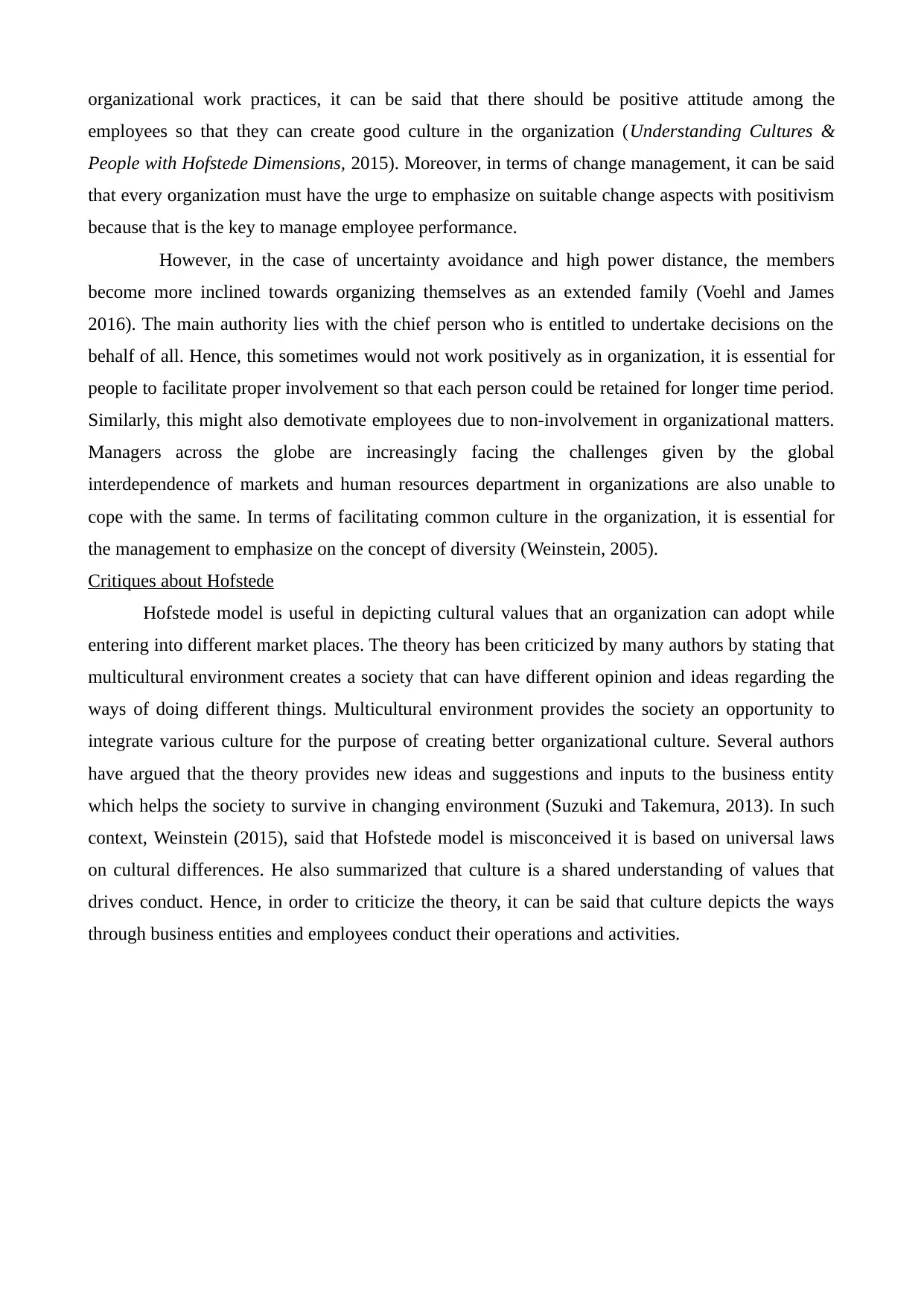
organizational work practices, it can be said that there should be positive attitude among the
employees so that they can create good culture in the organization (Understanding Cultures &
People with Hofstede Dimensions, 2015). Moreover, in terms of change management, it can be said
that every organization must have the urge to emphasize on suitable change aspects with positivism
because that is the key to manage employee performance.
However, in the case of uncertainty avoidance and high power distance, the members
become more inclined towards organizing themselves as an extended family (Voehl and James
2016). The main authority lies with the chief person who is entitled to undertake decisions on the
behalf of all. Hence, this sometimes would not work positively as in organization, it is essential for
people to facilitate proper involvement so that each person could be retained for longer time period.
Similarly, this might also demotivate employees due to non-involvement in organizational matters.
Managers across the globe are increasingly facing the challenges given by the global
interdependence of markets and human resources department in organizations are also unable to
cope with the same. In terms of facilitating common culture in the organization, it is essential for
the management to emphasize on the concept of diversity (Weinstein, 2005).
Critiques about Hofstede
Hofstede model is useful in depicting cultural values that an organization can adopt while
entering into different market places. The theory has been criticized by many authors by stating that
multicultural environment creates a society that can have different opinion and ideas regarding the
ways of doing different things. Multicultural environment provides the society an opportunity to
integrate various culture for the purpose of creating better organizational culture. Several authors
have argued that the theory provides new ideas and suggestions and inputs to the business entity
which helps the society to survive in changing environment (Suzuki and Takemura, 2013). In such
context, Weinstein (2015), said that Hofstede model is misconceived it is based on universal laws
on cultural differences. He also summarized that culture is a shared understanding of values that
drives conduct. Hence, in order to criticize the theory, it can be said that culture depicts the ways
through business entities and employees conduct their operations and activities.
employees so that they can create good culture in the organization (Understanding Cultures &
People with Hofstede Dimensions, 2015). Moreover, in terms of change management, it can be said
that every organization must have the urge to emphasize on suitable change aspects with positivism
because that is the key to manage employee performance.
However, in the case of uncertainty avoidance and high power distance, the members
become more inclined towards organizing themselves as an extended family (Voehl and James
2016). The main authority lies with the chief person who is entitled to undertake decisions on the
behalf of all. Hence, this sometimes would not work positively as in organization, it is essential for
people to facilitate proper involvement so that each person could be retained for longer time period.
Similarly, this might also demotivate employees due to non-involvement in organizational matters.
Managers across the globe are increasingly facing the challenges given by the global
interdependence of markets and human resources department in organizations are also unable to
cope with the same. In terms of facilitating common culture in the organization, it is essential for
the management to emphasize on the concept of diversity (Weinstein, 2005).
Critiques about Hofstede
Hofstede model is useful in depicting cultural values that an organization can adopt while
entering into different market places. The theory has been criticized by many authors by stating that
multicultural environment creates a society that can have different opinion and ideas regarding the
ways of doing different things. Multicultural environment provides the society an opportunity to
integrate various culture for the purpose of creating better organizational culture. Several authors
have argued that the theory provides new ideas and suggestions and inputs to the business entity
which helps the society to survive in changing environment (Suzuki and Takemura, 2013). In such
context, Weinstein (2015), said that Hofstede model is misconceived it is based on universal laws
on cultural differences. He also summarized that culture is a shared understanding of values that
drives conduct. Hence, in order to criticize the theory, it can be said that culture depicts the ways
through business entities and employees conduct their operations and activities.
⊘ This is a preview!⊘
Do you want full access?
Subscribe today to unlock all pages.

Trusted by 1+ million students worldwide
1 out of 30
Related Documents
Your All-in-One AI-Powered Toolkit for Academic Success.
+13062052269
info@desklib.com
Available 24*7 on WhatsApp / Email
![[object Object]](/_next/static/media/star-bottom.7253800d.svg)
Unlock your academic potential
Copyright © 2020–2025 A2Z Services. All Rights Reserved. Developed and managed by ZUCOL.





